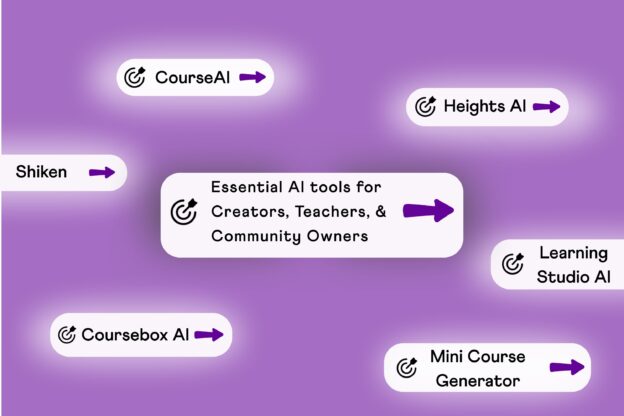Are you looking to create an online course and trying to decide which platform to use? With so many options available, it can be overwhelming to choose the right one that fits your needs. Two popular platforms that you might have heard of are BuddyBoss and Kajabi.
In this article, we will be comparing the features of BuddyBoss vs Kajabi to help you make an informed decision. BuddyBoss is a highly flexible online learning platform built on WordPress, while Kajabi is a SaaS solution provider for course creators. Both platforms have their strengths and weaknesses, and which one you choose depends on your specific requirements.
We’ll be looking at several aspects of these platforms, including their ecosystem, customization options, scalability, features, support, pricing, and more.
By the end of this article, you’ll have a clear understanding of how BuddyBoss and Kajabi compare, and which one is the better choice for your online course.
So, let’s dive in and take you into a detail comparison of BuddyBoss vs Kajabi!
Brief Overview of BuddyBoss vs Kajabi
First, let’s take a brief overview of BuddyBoss and Kajabi.

BuddyBoss is built on WordPress, which is an open-source platform that provides you with the flexibility, control, and freedom to launch and scale a successful online business. BuddyBoss is a white-label open source solution that is designed to adopt your brand. It integrates with LearnDash, one of the most popular WordPress LMS (Learning Management System) solutions on the market. BuddyBoss also provides a powerful, yet simple and elegant user interface for your learners, and lets you launch native mobile apps for your online course. BuddyBoss also offers gamification, student assessment, live stream, collaboration, and community features, among others.
On the other hand, Kajabi is an all-in-one platform that allows you to create, market, and sell your online courses. It offers customizable templates and intuitive design tools, making it easy to create a mini-course or even a full-blown signature program. Stripe and PayPal integrations make selling your online course seamless. The Kajabi mobile app gives customers one-click access from wherever they are, without having to remember passwords or rely on clunky mobile browsers. Kajabi also offers email marketing, live events and webinars, content creation features, and customer support, among others.
Now that we have a brief overview of both platforms, let’s dive deeper into the key features and benefits of BuddyBoss and Kajabi, and compare them side by side.
BuddyBoss vs Kajabi Compared
BuddyBoss and Kajabi are two different e-learning platforms with distinct features and capabilities. Let’s compare them and see which one is better suited for your online course or membership website.
1. Ecosystem
BuddyBoss is built on WordPress, an open-source platform that provides users with more flexibility and control over their website. WordPress is widely popular and has a vast community of developers and designers that provide customizations, plugins, and themes. BuddyBoss leverages the power of WordPress by integrating the LearnDash LMS, which is one of the most popular and powerful WordPress LMS plugins on the market. Apart from that BuddyBoss offers seamless integration with hundreds of third-party plugins for everything from design to email marketing. BuddyBoss also offers a solution to let you launch native mobile apps for your online courses, giving your students access to your content from anywhere.
On the other hand, Kajabi is a SaaS platform that provides everything you need to create and sell online courses. It has an all-in-one platform that includes a website builder, email marketing, membership site, and online course creation tools. While Kajabi provides an intuitive interface and quick setup, it’s less flexible than WordPress and BuddyBoss.
2. Customization
When it comes to the comparison of BuddyBoss vs Kajabi in terms of customization, the former offers a fully white-label solution with all the customization options provided by WordPress. It means you can customize every aspect of your website, from the theme layout to the branding and even custom headers and footers. BuddyBoss also has an easy-to-use demo import feature that lets you import pre-built layouts and pages with a single click. It also supports multilingual websites, RTL (Right-to-Left) languages, and popular page builders like Gutenberg and Elementor. All these customization options allow you to create a unique and engaging online course experience for your learners.
Kajabi also provides customization options, but it’s limited to their built-in integrated website builder that comes with Kajabi. It has a drag-and-drop interface that allows you to create and customize your website’s pages, but it has less flexibility than what WordPress, page builders like Elementor and BuddyBoss combined can offer.
3. Scalability
Scalability is a crucial factor when it comes to online courses and membership sites. BuddyBoss has no limit on the number of customers or admins, which means you can scale your business without worrying about any limitations. BuddyBoss also provides group functionality that mimics a classroom setting with integrated courses, discussion forums, and advanced Zoom integration. It allows you to create one-time and recurring online class sessions and Zoom meetings for a specific audience based on the group they belong to.
Kajabi, on the other hand, has different pricing plans with varying limits on the number of customers. The basic plan allows up to 1000 customers, while the pro plan allows up to 20,000 customers. However, you have to pay extra for more advanced features like the ability to remove Kajabi branding and increase the number of admins.
4. Online Course Features
Now let’s compare BuddyBoss vs Kajabi, in terms of online course features. While both offer a lot of cool features, with BuddyBoss having the edge over Kajabi. Here is a detailed comparison of BuddyBoss and Kajabi in terms of online course features:
i. Student Assessment:
BuddyBoss offers a comprehensive student assessment system with multiple question types such as single choice, multiple choice, free text, sorting, matching, essay, and fill-in-the-blank. It also allows multimedia supported Q&A using audio, video, and images. Admins can set manual limitations such as limiting attempts, blocking progression, and setting time limits. They can also choose display settings such as showing all, one at a time, several on a page, randomizing, and allowing skips.
On the other hand, Kajabi only allows users to create standardized tests, questionnaires, and surveys. They also offer an option to let learners go to the next lesson only after completing an assessment, which BuddyBoss also has.
ii. Gamification:
Both BuddyBoss and Kajabi offer gamification features like points, rewards, badges, levels, challenges, leaderboards, and lesson unlocks.
iii. Live Stream:
Live streaming is an important part of an online course, and both BuddyBoss and Kajabi offer this feature. BuddyBoss integrates with Zoom, which means course creators can create virtual classrooms with the power of Zoom. Both virtual classroom and virtual broadcast are possible with this feature. Kajabi, on the other hand, allows you to create a meetup, which is not as powerful as Zoom, which is a dedicated communication tool. They also let you attach a YouTube live stream.
iv. Collaboration:
Both BuddyBoss and Kajabi have collaboration opportunities with the power of groups, direct message, and social networking features.
5. Community Features
In terms of community features, Kajabi lags far behind BuddyBoss. Specially, with the ability to create a fully-functional social network for your learners, BuddyBoss takes community to the next level. Take a look at the detailed comparison of BuddyBoss and Kajabi in terms of online course features:
i. Social Networking:
BuddyBoss has a complete social networking feature-suite with a newsfeed, public posts and photo sharing, connection, direct message, and groups. Kajabi, on the other hand, does not have a social networking feature, but they do have a community feature where users can join and communicate, post and message each other. BuddyBoss provides a personalized news feed similar to Facebook, which is not available on Kajabi. BuddyBoss also provides features like friend requests, user mentions, and hashtag support, which are not available on Kajabi.
ii. Profile:
BuddyBoss offers users the ability to create comprehensive profiles that are visible to other learners. This feature allows users to add their photo, cover image, bio, and other details. Kajabi does have a profile feature, but it is not as comprehensive, so users cannot add detailed information about themselves.
iii. Posts:
BuddyBoss has a posts feature that allows users to post both on their timeline or in a group. Kajabi users can only post inside a community. BuddyBoss also provides more options for posts, such as the ability to tag other users, add multimedia, and schedule posts for later.
iv. News Feed:
BuddyBoss has a fully featured personal newsfeed and a separate group newsfeed, which provides users with the latest updates from their connections and groups. Kajabi only has a group newsfeed.
v. Direct Message:
Both BuddyBoss and Kajabi let users direct messages to each other. This feature allows users to have private conversations with each other. BuddyBoss and Kajabi, both also provide additional features such as group messaging and multimedia support in direct messages.
6. Mobile App
BuddyBoss and Kajabi differ significantly in their mobile app offerings. While Kajabi does not allow users to create a white-label mobile app, BuddyBoss offers a fully white-label native app for both Android and iOS. This means that the course creator can publish an app in the app stores with their branding, which can enhance their brand identity and user engagement.
Moreover, the BuddyBoss app allows users to access their course material offline, making it possible for users to access course material even without internet connectivity. Additionally, the app features real-time data synchronization between devices, ensuring that users can access the most up-to-date course material.
Finally, the BuddyBoss app is secure, with 2FA security features that can help protect users’ sensitive data from unauthorized access.
7. Monetization
Both BuddyBoss and Kajabi offer multiple monetization opportunities to course creators. For instance, BuddyBoss provides various monetization features such as one-time payments, payment plans, subscriptions, one-click upsells, free trials, affiliates, coupons, bulk orders, and bundles. Similarly, Kajabi also offers monetization options like selling digital products, creating membership sites, and launching online courses.
8. Online Store
Let’s look into the comparison of BuddyBoss vs Kajabi in terms of online store features. Both the tools provide online store features to allow course creators to sell digital products and courses alongside their main business. BuddyBoss goes a step further by offering multi-vendor online store capabilities and integration with WC4BP and WC Vendors Pro. This means that BuddyBoss customers can easily run a full-fledged online store in addition to their course business.
On the other hand, while Kajabi also has an online store feature, it is not as robust as the one offered by BuddyBoss. This means that Kajabi may not be the best choice for course creators looking to build a comprehensive online store.
9. Membership Support
BuddyBoss and Kajabi both have membership support features, but BuddyBoss offers more flexibility as it integrates with popular WordPress membership plugins like MemberPress, Paid Memberships Pro, WishList Member, WooCommerce Memberships, WooCommerce Subscriptions, and Memberium. This integration allows BuddyBoss users to leverage powerful membership features and create customizable membership levels.
In comparison, Kajabi has a built-in membership feature, but it lacks the advanced features that the top WordPress membership plugins provide, which may limit the flexibility for course creators who want to create membership-based courses.
10. Content Creation Features
Both BuddyBoss and Kajabi have a blog feature. BuddyBoss offers a dedicated blog feature where you can create, publish and share blog posts on their social media handles, while Kajabi also offers a blog feature that allows the same. BuddyBoss goes a step further by allowing learners to bookmark blogs for reading later, a feature that Kajabi does not offer.
11. Email Marketing
BuddyBoss offers integration with popular WordPress email marketing plugins such as Mailpoet, FluentCRM, Thrive Leads, and a few more. These integrations give BuddyBoss users quality email marketing options.
On the other hand, Kajabi offers comprehensive email marketing with its built-in email marketing feature. Course creators can design and send newsletters, marketing emails, and automated email campaigns to their students without having to use a third-party email marketing tool.
12. Developer Support
BuddyBoss is a developer-friendly solution, as it is powered by an open-source platform. This provides an opportunity for developers to extend the capabilities of the BuddyBoss-built websites, adding custom code, plugins, and features. This means that BuddyBoss users can create custom integrations with other tools, customize their website to their liking, and extend the functionality of the platform.
Kajabi, on the other hand, is not as developer-friendly. You can only customize the website made by Kajabi, meaning users are restricted in terms of adding new features or integrations. The app from Kajabi is also not customizable, meaning users will be restricted to what is offered to them.
13. Integrations
BuddyBoss has integration with hundreds of compatible apps and plugins to extend its capabilities. This is largely due to the fact that BuddyBoss works on WordPress, which opens the door to integrate with a lot of plugins from the WordPress environment.
Kajabi also offers some integrations, although at this moment, it has a total of 16 integrations, far lower than BuddyBoss.
14. Customer Support

Both BuddyBoss and Kajabi offer 24/7 support. BuddyBoss has a dedicated support team, providing support through the help desk. The support team is well-versed in WordPress, BuddyBoss, and the plugins used in conjunction with the platform. Additionally, BuddyBoss has an extensive knowledge base that is easily accessible to users.
Kajabi also has a dedicated support team to provide customer support. However, their support is not available 24/7 for Basic plan users, but limited to Growth and Pro plan users. Kajabi also has a knowledge base where users can find product documentation.
15. Pricing
BuddyBoss offers a more affordable pricing option compared to Kajabi, especially for those who are just starting their online course business. With a starting price of $299 per year, BuddyBoss is more accessible for small business owners or individual course creators who may not have a huge budget for their platform.
On the other hand, Kajabi has a slightly higher starting price of $119 per month, but its feature set may still not be as robust as what BuddyBoss has to offer.
BuddyBoss vs Kajabi – Side by Side
Both BuddyBoss and Kajabi have their strengths and weaknesses depending on your needs. Here is a detail comparison of BuddyBoss vs Kajabi:
| BuddyBoss | Kajabi | |
| Courses | ||
| Members Dashboard | ✅ | ✅ |
| Live Sessions | ✅ | ✅ |
| Collaboration | ✅ | ❌ |
| Gamification | ✅ | ✅ |
| Microlearning | ✅ | ✅ |
| Lesson Unlocks | ✅ | ✅ |
| Quizzes & Surveys | ✅ | ✅ (Limited options) |
| Certificates | ✅ | ✅ |
| Community | ||
| Profiles | ✅ | ✅ |
| Posts | ✅ | ✅ |
| Friends & Followers | ✅ | ❌ |
| Comment, Like & Share | ✅ | ❌ (No shares) |
| Direct Messages | ✅ | ✅ |
| Mentions | ✅ | ❌ |
| Activity Feeds | ✅ | ✅ |
| Social Search | ✅ | ✅ |
| Online Store | ✅ | ✅ |
| Platform Features | ||
| Native Mobile App (shared) | ❌ | ✅ |
| Native Mobile App (white-labeled) | ✅ (Addon) | ❌ |
| Drag & Drop Website Builder | ✅ | ✅ |
| Blog | ✅ | ✅ |
| Page Template | ✅ | ✅ |
| Site Templates | ✅ | ✅ |
| Fully Customizable | ✅ | ❌ |
| Custom Domain | ✅ | ✅ |
| Collect Payments | ✅ (Addon) | ✅ Paypal or Stripe |
| Affiliate Program | ✅ (Addon) | ✅ |
| Translations | ✅ | ✅ |
| Email Notifications | ✅ | ✅ |
| In-App Notifications | ✅ | ❌ |
| Push Notifications | ✅ | ✅ |
| API Access | ✅ | ❌ |
| Developer Support | ✅ | ❌ |
| Open Source | ✅ | ❌ |
| Limits | ||
| Members | Unlimited | 10,000 |
| Admins | Unlimited | 10 |
| Courses | Unlimited | 15 |
| Groups | ✅ | ✅ |
| Events | ✅ | ✅ |
| Job Boards | ✅ | ❌ |
| Price (Most Popular) | $299/year | $1,908/year |
The Final Verdict on BuddyBoss vs Kajabi
Both BuddyBoss and Kajabi are powerful platforms that can help you create and sell online courses. However, which platform you choose ultimately depends on your specific needs.
If you value flexibility, customization, and scalability, then BuddyBoss is the better choice. BuddyBoss is built on WordPress, which is an open-source platform with a vast ecosystem of developers, designers, and third-party plugins. BuddyBoss provides a fully white-labeled and customizable solution that integrates with the popular LearnDash LMS plugin. It also offers a mobile app solution, gamification, live streaming, and community features, among others. BuddyBoss is a powerful platform that can help you create a unique and engaging online course experience.
On the other hand, if you’re looking for an all-in-one platform that provides everything you need to create and sell online courses, then Kajabi might be the better choice. Kajabi provides an intuitive interface and quick setup, making it easy to create and customize your online courses. It also offers email marketing, live events and webinars, content creation features, and customer support.
In conclusion, BuddyBoss is the better choice if you want more control, flexibility, and scalability over your online course or membership site. Kajabi is a great all-in-one platform that provides everything you need to create and sell online courses, but it’s less flexible than BuddyBoss.












